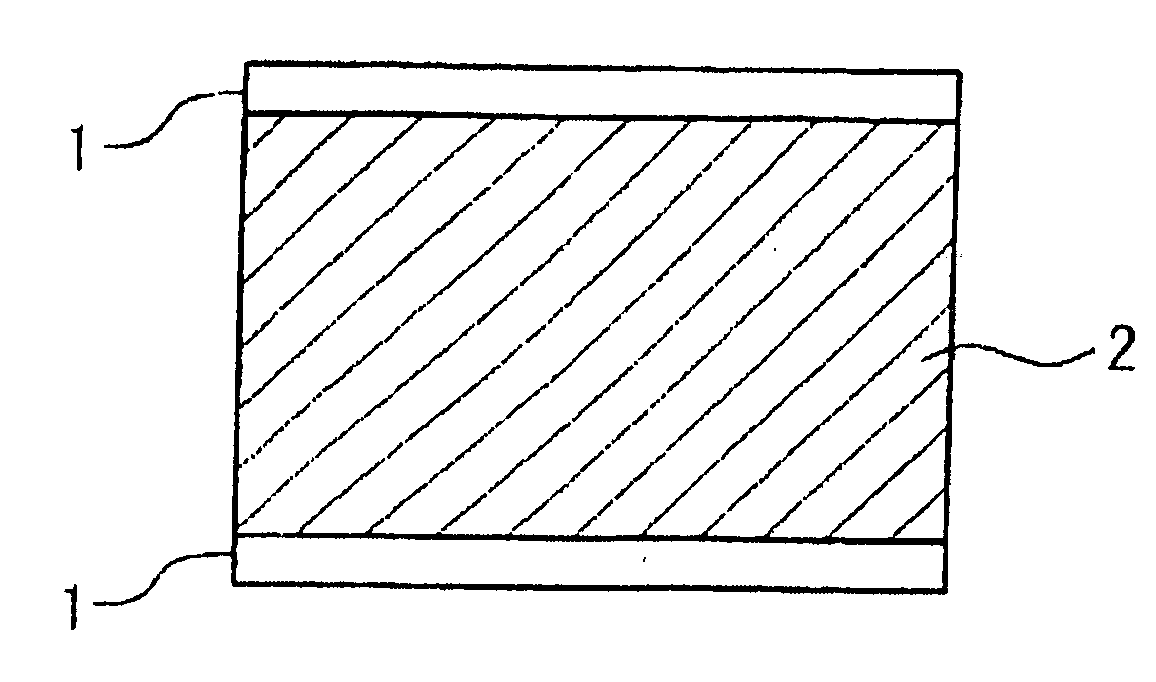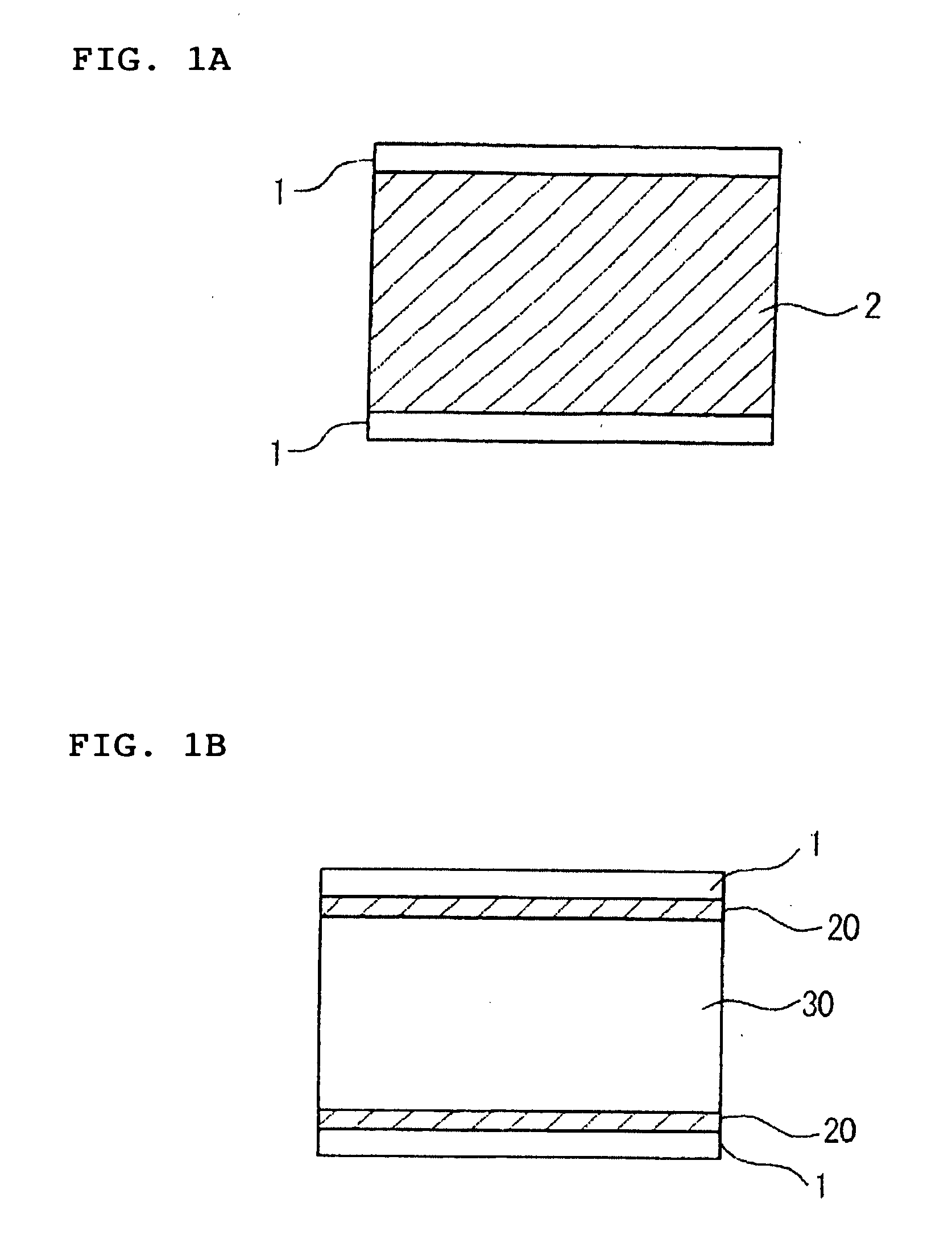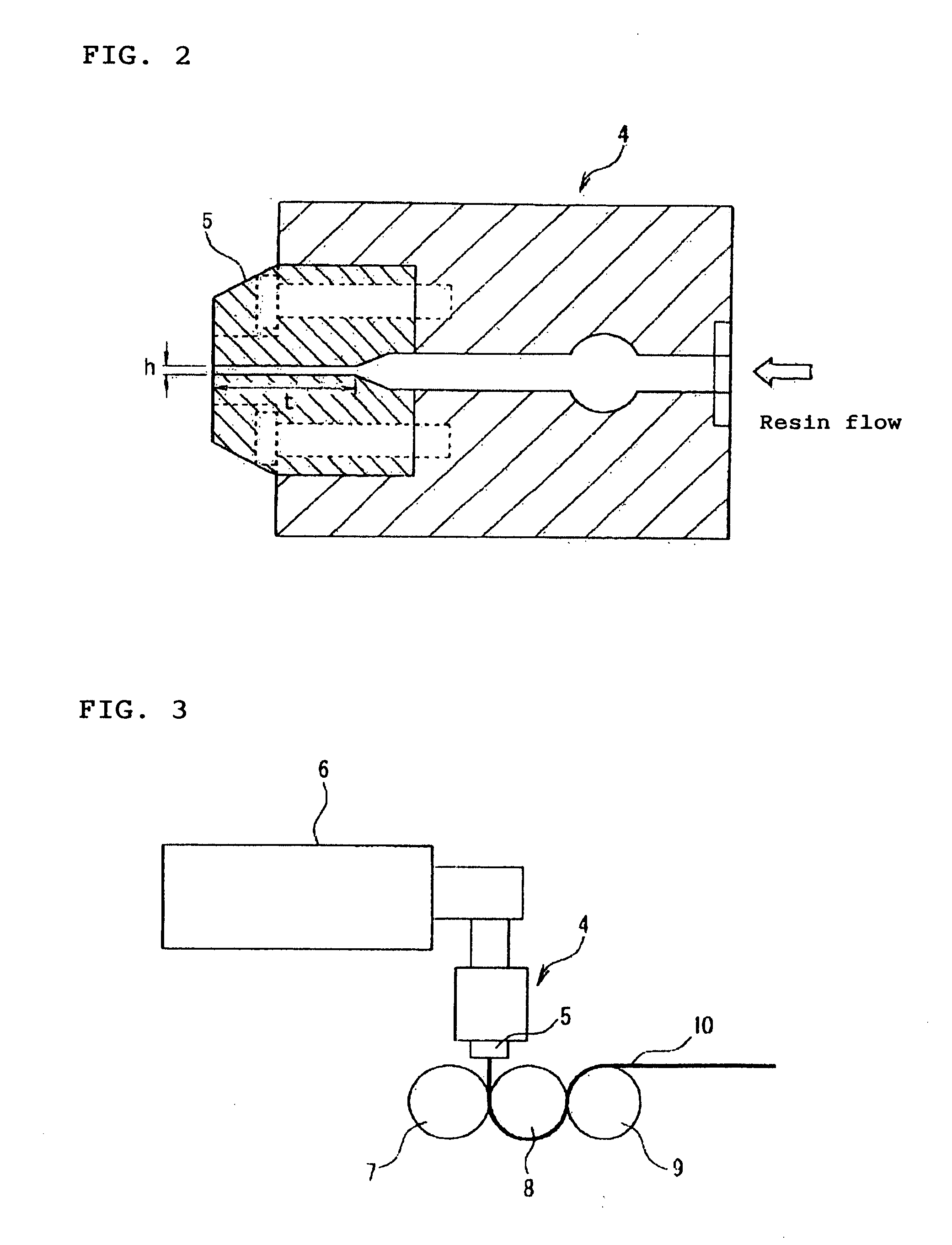[0056]In the present invention, the transparent resins used in respective layers may be the same as or different from each other, but it is preferable that the resins are the same as each other, because it is possible to keep the
haze low even when the wastes such as the sheet edge
cut off for product finishing are recycled partially as the base resin for the antistatic or core layer of the multilayer sheet. However, even if the transparent resins used in respective layers are different from each other, it is possible to keep the
haze low even when the resins are recycled partially for the core layer of the multilayer sheet, if the refractive indexes are close to each other; and thus, the resins may be recycled in the range that does not impair the
advantage of the present invention.
[0057]The transparent resin used in the present invention is a
thermoplastic resin having a total light
transmittance (JIS K7136 (2000), hereinafter, may be referred to as total light
transmittance R) of 65% or higher and a cloudiness indicator
haze (JIS K7136 (2000), hereinafter, may be referred to as haze R) of 15% or lower, as determined as molded into a smooth-surfaced flat plate having a thickness of 2 mm. Higher total light
transmittance R and smaller haze R lead to increase in the distinctness of image of the multilayer sheet according to the present invention and decrease in the haze of the multilayer sheet (hereinafter, may be referred to as haze S). Accordingly, the total light transmittance R of the transparent resin for use in the present invention is preferably 75% or higher, more preferably 85% or higher, still more preferably 90% or higher, and the haze R thereof is preferably 12% or lower, more preferably 10% or lower, still more preferably 5% or lower, and most preferably 3% or lower.
[0058]Generally, even the same kind of transparent resins are used, increase in thickness leads to decrease in total light transmittance R and also increase in haze R at the same time. The antistatic layer C or the core layer according to the present invention occupy most of the thickness of the multilayer sheet (80% or higher of entire thickness), and it is preferable that the transparent resin B, the base resin for the antistatic layer C or the transparent resin C, the base resin for the core layer, has a higher total light transmittance R or a lower haze R, for making the distinctness of image of multilayer sheet more favorable and the haze S lower. The total light transmittance R and the haze R are selected properly according to the difference in requirements in the desired application. For example, for use in the
optical field, a transparent resin having a higher total light transmittance R and a low haze R is particularly preferable.
[0059]When the multilayer sheet according to the present invention is a multilayer sheet in the three-layer structure of the first embodiment, i.e., in the three-layer structure of an antistatic layer C constituted of a transparent resin B as the base resin and an antistatic agent and coat layers constituted of a transparent resin A as the base resin, the difference in
refractive index between the transparent resin B and the polymeric antistatic agent is preferably 0.05 or less. A difference in
refractive index of more than 0.05 results in increase in haze S, deterioration in distinctness of image and thus, disappearance of clear transparency, when the resins with different refractive indices are blended. For that reason, the difference in
refractive index is more preferably 0.04 or less, more preferably 0.03 or less, and the difference in refractive index is most preferably 0 (zero).
[0060]When the multilayer sheet according to the present invention is a multilayer sheet in the five-
layered structure in the second embodiment, i.e., in the five-
layered structure having a core layer constituted a transparent resin C as the base resin, antistatic layers M (antistatic layers constituted of a transparent resin B as the base resin and an antistatic agent) and coat layers constituted of a transparent resin A as the base resin and not containing a polymeric antistatic agent and then laminating them in order of coat layer / antistatic layer M / core layer / antistatic layer M / coat layer, the difference in refractive index between the transparent resin B and the polymeric antistatic agent is, similarly to the first embodiment, preferably 0.05 or less, more preferably 0.04 or less, still more preferably 0.03 or less, and the difference in refractive index is most preferably 0 (zero). Similarly to the transparent resin C, the total light transmittance R of the transparent resin B is preferably higher and the haze R lower, but, because the antistatic layer M can be thinned in the case of the second embodiment where in antistatic layers M are formed on both faces of the core layer, it is possible to reduce the influence of the transparent resin B on distinctness of image, and thus, favorably the transparency is unaffected as a whole even when the total light transmittance R of the transparent resin B is slightly lower than that of the transparent resin C. When the multilayer sheet is a sheet in the second embodiment, the core layer therein preferably contains no antistatic agent from the point of
raw material cost, but may contain the antistatic agent if the addition amount is small (5 wt % or lower, preferably 3 wt % or lower, more preferably 1 wt % or lower in 100 wt % of the core layer). When wastes of the multilayer sheeL such as edge sheet are to be recycled, they are preferably added to the core layer or the antistatic layer M, but addition of the wastes such as edge sheet to the core layer is also effective in increasing the
adhesive strength between the antistatic layer M and the core layer.
[0061]As described above, the coat layer in the multilayer sheet according to the present invention, which is formed mainly for prevention of contamination of the roll surface by the polymeric antistatic agent, does not contain the polymeric antistatic agent fundamentally. However, the polymeric antistatic agent may be added in an extremely small amount, if it is in the range that does not cause any trouble in production of the multilayer sheet according to the present invention. Thus, the concept of the “coat layer constituted of a transparent resin A as the base resin but not containing a polymeric antistatic agent” includes a “coat layer constituted a transparent resin A as the base resin and containing also a polymeric antistatic agent in an amount in the range that does not inhibit prevention of the contamination of the roll surface caused by the polymeric antistatic agent”. For example, a polymeric antistatic agent higher in
metal adhesion may be added in an amount of about 2 wt % (wt % with respect to the sum of the polymeric antistatic agent and the transparent resin A) or less. However, the addition amount is preferably smaller, preferably 1 wt % or smaller, more preferably 0.3 wt % or smaller. Alternatively, a polymeric antistatic agent lower in
metal adhesion may be added in an addition amount of about 3 wt % (wt % with respect to the sum of the polymeric antistatic agent and the transparent resin A) or less. However, the addition amount of the polymeric antistatic agent lower in
metal adhesion is also preferably lower, preferably 2 wt % or lower, more preferably 1 wt % or lower.
 Login to View More
Login to View More 


